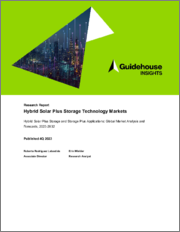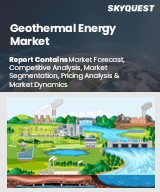
|
시장보고서
상품코드
1397927
하이브리드 솔라 플러스 스토리지 기술 시장 - 하이브리드 솔라 플러스 스토리지 및 스토리지 플러스 애플리케이션 : 세계 시장 분석 및 예측(2023-2032년)Hybrid Solar Plus Storage Technology Markets - Hybrid Solar Plus Storage and Storage Plus Applications: Global Market Analysis and Forecasts, 2023-2032 |
||||||
태양광을 통한 간헐적 재생에너지 발전 기술은 전 세계 발전량에서 차지하는 비중이 사상 최고치를 기록할 정도로 빠르게 성장했으며, 현재도 계속 확대되고 있습니다. 기술 개선과 비용 절감, 정책적 지원과 전환이 이러한 성장을 뒷받침하고 있으며, 2022년에는 기록적인 규모의 재생에너지 발전 설비가 도입되어 전 세계 재생에너지 공급량이 약 8% 증가했습니다. 장기 계약, 전력망에 대한 우선 접근권, 자금 조달의 증가는 간헐적 재생에너지 발전 기술의 도입이 향후 10년간 빠르게 확대될 것임을 시사합니다. 태양광발전으로 인한 전력 공급의 변동성을 감안할 때, 증가하는 재생에너지를 안정적으로 그리고 비용 효율적으로 전력망에 통합하기 위해서는 전력망 유연성을 향상시키는 솔루션이 필요합니다.
이 보고서의 지역별 예측에는 기술 가격도 포함되어 있습니다. 모든 예측은 2023년부터 2032년까지 10년간을 대상으로 합니다. 각 지역에서 건설 및 계획 중인 신규 프로젝트, COVID-19 팬데믹으로 인한 장기적인 혼란, 인플레이션 억제법(IRA)의 시행, 현재의 경제적 어려움 등을 고려하여 2021년 예측에서 수정되었습니다.
북미 시장은 재생에너지 + 스토리지 분야에서 현재 세계 최대 시장이며, 적어도 2032년까지 그 자리를 지킬 것으로 예상됩니다. 이 지역의 성장을 주도하는 것은 미국의 신규 솔라 플러스 스토리지(태양광 + 저장) 프로젝트와 하이브리드 시스템 성장을 촉진하는 정책 변화로, 2023년에는 북미에서 태양광과 함께 11,881MW의 에너지저장장치(ESS)가 새로 설치될 것으로 예상됩니다. 2032년까지 아시아태평양은 연간 13,488MW의 신규 태양광 및 저장 시스템 용량이 설치될 것으로 예상되며, 전체 시장 규모에서 두 번째로 큰 시장으로 성장할 것으로 전망됩니다.
목차
제1장 주요 요약
제2장 시장 문제
- 성장 촉진요인
- 하이브리드 솔라 플러스 스토리지 구입 계약 가격
- 에너지 법규 방침 변경
- 원격지의 마이크로그리드
- 화석연료 발전소 폐지
- 책임 있는 토지 이용
- 유틸리티 계획 과제
- 성장 억제요인
- 예측
- 시장 완화와 물리적 억제
- 시장 참여·스케줄링 소프트웨어
- 능력 인증
- 오퍼 파라미터
- 상호접속
- 자원 계획과 배분
- 경제적 어려움에 의한 영향
- 스토리지 플러스 애플리케이션
- 운전 억제와 송전 혼잡
- 에너지 가격 재정거래
- 재생에너지 출력
- 용량 시장과 자원 적절성
- 보조 서비스
- 원격 마이크로그리드와 도서 지역 지원
제3장 업계의 밸류체인
- 리튬이온 배터리 밸류스트림 컴포넌트
- 업스트림에 대한 영향
- 미드스트림에 대한 영향
- 다운스트림에 대한 영향
- 태양광발전 인버터 밸류체인
- 업스트림에 대한 영향
- 미드스트림에 대한 영향
- 다운스트림에 대한 영향
- 그리드 스토리지 프로젝트 : 기술의 비교
제4장 시장 예측
- 분석 방법과 가정
- 지속되는 COVID-19 팬데믹의 영향
- 지역별 예측
- 솔라 플러스 스토리지 매출 예측
제5장 결론과 제안
- 3개 주요 사항
- 유틸리티를 위한 제안
- 규제 당국을 위한 제안
제6장 두문자어와 약어 리스트
제7장 목차
제8장 도표
제9장 분석 범위, 정보 출처와 분석 방법, 주석
ksm 24.01.05Intermittent renewable energy generation technologies via solar PV have surged to capture a record share of global electricity generation and continue to expand. Technology improvements, cost reductions, and policy support and shifts underpin this growth. Record breaking renewable electricity capacity installations in 2022 have aided in global renewable energy supply increasing by about 8%. Long-term contracts, priority access to the grid, and increased funding suggest that the deployment of intermittent renewable energy generation technologies will continue to expand rapidly in the coming decade. Given the variability of power supply from solar PV, integrating increased levels of renewable energy onto electricity grids reliably and cost-effectively will require solutions that improve grid flexibility.
The forecasts in this Guidehouse Insights study, which are segmented by region include technology pricing. All forecasts cover the 10-year period from 2023 to 2032. These forecasts have been revised from 2021 projections to account for new projects in the regional pipeline, lingering disruptions from the COVID-19 pandemic, the launch of the Inflation Reduction Act (IRA), and current economic hardship factors.
The North American market is currently the largest globally for renewables plus storage and projected to remain so through at least 2032. Leading the region's growth are new solar plus storage projects in the US, and policy changes that encourage growth of hybrid systems. In 2023, North America is expected to see 11,881 MW of new energy storage system (ESS) capacity installed alongside solar PV, and 27,259 MW of total utility-scale power capacity. Through 2032, Asia Pacific is expected to remain the second largest market overall with an annual 13,488 MW of new solar PV plus storage capacity.
Table of Contents
1. Executive Summary
- 1.1 Market Introduction
- 1.2 Market Forecasts
2. Market Issues
- 2.1 Drivers
- 2.1.1 Hybrid Solar Plus Storage Purchase Agreement Prices
- 2.1.2 Policy Changes to Energy Codes
- 2.1.3 Microgrids in Remote Regions
- 2.1.4 Fossil Fuel Power Plant Retirements
- 2.1.5 Responsible Land Use
- 2.1.6 Utility Planning Challenges
- 2.2 Barriers
- 2.2.1 Forecasting
- 2.2.2 Market Mitigation and Physical Withholding
- 2.2.3 Market Participation and Scheduling Software
- 2.2.4 Capacity Accreditation
- 2.2.5 Offer Parameters
- 2.2.6 Interconnection
- 2.2.7 Resource Planning and Distribution
- 2.2.8 Impacts from Economic Hardship
- 2.3 Storage Plus Applications
- 2.3.1 Curtailment and Transmission Congestion
- 2.3.2 Energy Price Arbitrage
- 2.3.3 Renewables Output
- 2.3.4 Capacity Markets and Resource Adequacy
- 2.3.5 Ancillary Services
- 2.3.6 Remote Microgrids and Support for Island Regions
3. Industry Value Chain
- 3.1 Li-ion Battery Value Stream Components
- 3.1.1 Upstream Impacts
- 3.1.2 Midstream Impacts
- 3.1.3 Downstream Impacts
- 3.2 Solar Inverter Value Chain
- 3.2.1 Upstream Impacts
- 3.2.2 Midstream Impacts
- 3.2.3 Downstream Impacts
- 3.3 Grid Storage Project Technology Comparisons
4. Market Forecasts
- 4.1 Methodology and Assumptions
- 4.1.1 Lingering COVID-19 Pandemic Impacts
- 4.2 Forecasts by Region
- 4.3 Solar Plus Storage Revenue Projections
5. Conclusions and Recommendations
- 5.1 Three Big Takeaways
- 5.2 Recommendations for Utilities
- 5.3 Recommendations for Regulators



















